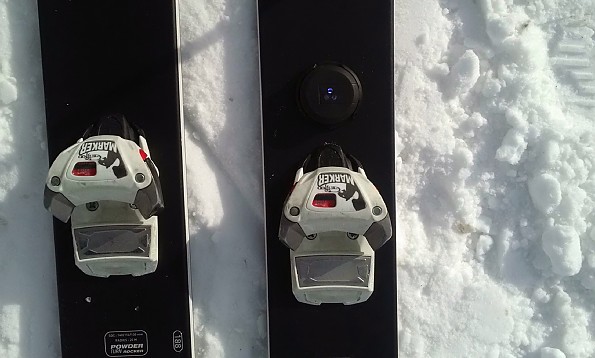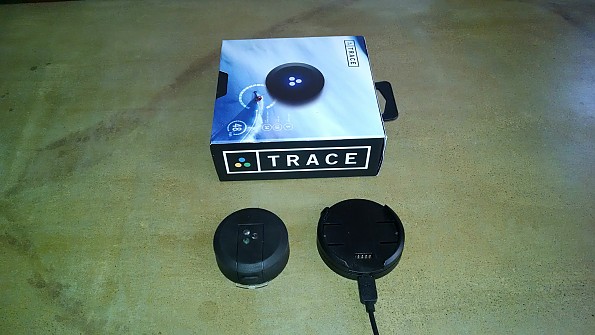Trace

Trace is a sports tracking system designed for snow and water sports. It's a GPS device that records a variety of information that is then downloaded to a smartphone or computer. This easy to use sports tracker is a useful tool for training or just all-around fun.
Pros
- Sport session tracking
- Easy to use
- Small and lightweight
- Lots of information
Cons
- App can be finicky at times
This small (1 7/8" x 3/4") device combines an advanced 9-axis inertial measurement unit (9X IMU) and GPS sensors to track a variety of sports including snow sports, water sports, and downhill mountain biking. The 9X IMU's ability to track air time and revolutions, along with the GPS's ability to add vertical descent, speed, and location, provides an accurate date map of a sports session.
Once a session is complete, the data is uploaded to the free Trace App which is available for Android and iPhone. Apple iPhone users can also pair their GoPro cameras with the Trace and upload the footage to the Trace Video Mac app. Within minutes, the footage will be broken into individual clips based on the session. Trace is presently working on a similar Android app.
The shock and waterproof Trace can store up to fifty sessions and its built-in battery, when fully charged, will operate for seven hours. A charging station and mounting block complete the Trace package. Trace offers a 30-day no risk money-back guarantee and it comes with a six-month warranty.
I was offered a Trace for testing by B Dot Media in conjunction with Traceup, the manufacturer. Testing of the Trace was done over the winter of 2015/16 skiing at Alpine Meadows/ Squaw Valley in the Sierra Nevada and Whistler Mountain in British Columbia.
While the Trace was charging in its dock, I went to the Trace website for mounting and operation instructions. The free Trace app was also downloaded to my Android phone.
Once the app has been installed the phone needs to be paired with the Trace as a Bluetooth device. A spot in front of the binding needs to be cleaned with alcohol and the self-adhesive mounting block can then be installed, paying attention so the placement arrow points forward toward the tip of the ski, snowboard or water craft.
Controlling the Trace is accomplished with one button and three LEDs. Once the unit is charged the LEDs will change from flashing green to solid green. It can then be placed in the mounting block and turned a quarter turn to lock it in place. Pressing the button will change the LEDs to yellow; this is the “searching for GPS” signal. Once the GPS signal has been acquired, the LEDs will turn blue and the Trace is now ready to record a session.
Before getting on the first lift of the day, I pushed the button once more. The LEDs will start blinking blue and signify it is now recording. After skiing, boarding, or surfing the session is ended by pressing the button once, which will return the LEDs to steady blue.
To upload the session to a phone, open the Trace app, pick "New Session" and follow the instructions. The two devices will sync and the session will be uploaded. At this time, a photo or information about your equipment can be added. When the session upload is complete of my day’s statistics will be displayed, each day will be organized by date and the ski area name will be listed. All runs made during the session will be overlaid on a map of the ski area. The session data can now be shared with Facebook, Instagram, or via text.
I found the mounting and operation instructions were very easy to follow and the Trace itself performed perfectly. Initially, the app would not sync properly with the phone, which was confusing. After I uninstalled, reinstalled and updated the Trace App it operated properly.
The amount of data the Trace records is extensive and not only is it available on the phones app, I also was sent an email. Opening a Trace session email opens up an entire data world. One of my sessions at Squaw Valley ski area showed data such as 3356 acres of skiable area, elevation of 6200 to 8566 feet and 29 lifts. Next, graphs showed a maximum speed of 52.4 miles an hour, steepest slopes skied was 51 degrees and a total vertical skied of 20,000 feet. Calories burned, distance skied, air time and a host of other interesting data were also featured.
The Trace website has a lot of extra features that allow users to join groups and be ranked among other users. While I am not a “young gun,” I really enjoyed seeing the actual data for each ski session and how it compares to other sessions. Being able to view my ski season and all its information in one place was very informative.
Trace does an excellent job of providing data on a day’s skiing session. Being able to see at a glance runs made, vertical descent, top speed, jumps, and more was a fun way to end a day. Much of the data available can be useful for training purposes for both the amateur and professional athlete.
Trace will work equally well mounted on a surfboard, stand-up paddleboard, kayak, or canoe. I kept the Trace after testing.
Details:
- Cost - $199.99
Source: tested or reviewed it for the manufacturer (I kept the product after testing.)
Your Review
Where to Buy
You May Like
Specs
| Price |
MSRP: $199.99 |



